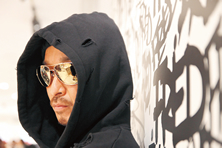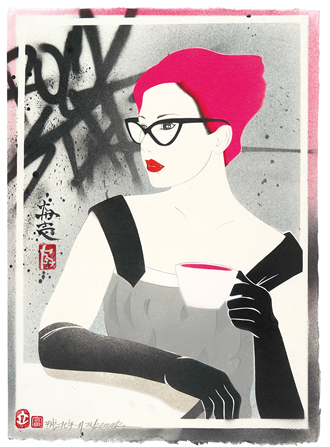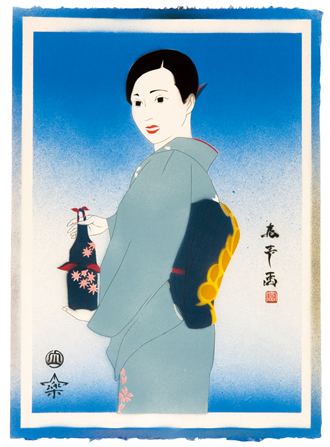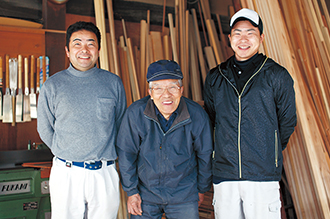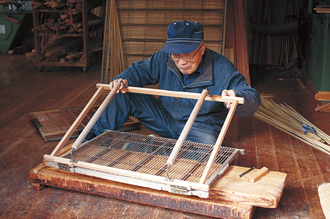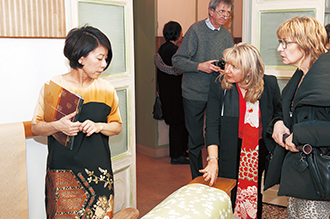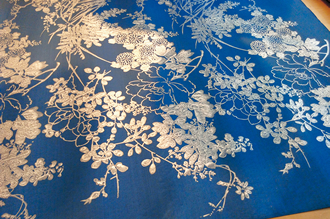niponica is a web magazine that introduces modern Japan to people all over the world.
2016 No.18
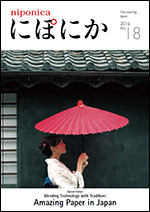
To read the e-book you need to have JavaScript enabled in your browser and a free Flash Player plug-in from Adobe Systems Inc. installed.
Amazing Paper in Japan

Paper Traditions Live On in New Ways
Washi paper has a history going back 1,300 years, and its traditions are alive and well today with growing possibilities for the future.
Photos: Miyamura Masanori
Washi and graffiti art: Graffiti artist TOMI-E
Ukiyoe woodblock prints had their heyday in the Edo period (1603-1867). Their subjects were often famous places or beautiful women, and they were incisive in depicting the times. A woodblock is used to print one color after another on the same sheet of washi paper to produce ukiyoe, but TOMI-E is very much a 21st century ukiyoe artist, spraying color on washi instead.
When he was 16 he went to the United States, where wall graffiti art was quite an eye-opener for him. He began working in the genre himself, and after returning to Japan he experimented in ways to express his own identity as a Japanese person through art. He came upon ukiyoe, and after that he decided to work with washi.
“Washi takes in ink well, giving a rich luster and colors that you couldn’t get with canvass or a wall. When I saw that, I knew I’d found what I was looking for.”
He was captivated. While studying the possibilities, he discovered washi made by the recognized Living National Treasure, Iwano Ichibei. Every one of Iwano’s sheets has its own spirit, each with a slightly different thickness and texture. Making the most of Iwano’s paper, TOMI-E’s approach to his own art form changed.
“A wall can be painted and then repainted on top of the old, but with washi paper you have only one chance to get it right. So I tend to concentrate more than before when using washi paper.”
Using spray to depict our own times on washi paper, TOMI-E is creating a new type of art.
Two works inspired by old ukiyoe prints of women. Whether the tones are vibrant or subtle, traditional washi paper brings them out beautifully, helping the artist achieve the expression he wants.
Three generations, linked by papermaking tools: Yoshida-ya Sashimono Joinery
Making washi by hand requires many kinds of tools. In Fukui Prefecture, where Echizen-washi paper is produced, such tools have been made by Yoshida-ya Sashimono Joinery for nearly 100 years. It is still making and repairing tools such as suki-geta (wooden frames), at a time when tool artisans are declining in number in Japan.
The person primarily in charge of work there is Yoshida Minoru. He is the third-generation owner and the father of the fourth-generation successor, Kiuchi Masa’aki. Wooden frames stand up well to water and are made with lightweight wood from a tree called Aomori hiba. It takes many years of experience to make a good wooden frame—for example, the thickness of the frame has to be calibrated to prevent them from bending under water pressure when the pulpy liquid is lifted. Masa’aki says, “I had a different kind of job before, but I didn’t want to see my father’s technical skills disappear with the passage of time.” This is why he decided to carry on the family’s work. They get orders from places throughout Japan. “It can be kind of stressful. But if we don’t keep at it, techniques could die out.”
Minoru’s grandson, Masayasu, is training in this craft. “I’ve wanted to do this kind of work ever since I was a kid. My grandfather is awesome—he can sense right away what people want in their tools, and he makes them accordingly. I want to be able to do that.” He certainly shows his dedication on the job.
People from three generations working together—they show how treasured techniques are being passed down through the years, helping to maintain washi manufacturing.
Presenting Edo-Karakami decorative paper charms to the world:Yanagi Tomoko, Interior Design Coordinator
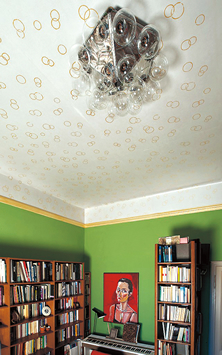
Washi impressed with golden mica decorates the ceiling of a house in Italy. The overlapping circle motif, called wa-chigai works well with the hoop-like lamps.
Edo-Karakami is a kind of washi with a wide range of decoration. Its ornamental techniques, which were developed in old Edo (now Tokyo), can be used to create just about any kind of pattern, by combining colors and washi paper. It is often used on fusuma sliding doors and byobu screens, and it was an important element in traditional Japanese houses. Today, Yanagi Tomoko is working at making Edo-Karakami better known outside Japan.
For her, it all started while searching for ways to use washi for retail space design. Then she happened to visit Tokyo Matsuya, an Edo-Karakami wholesaler.
“Edo-Karakami decorative paper expresses the essence of the traditions and craftsmanship seen in the patterns and colors which the Japanese have been fond of. I was amazed.”
She had studied architecture in Italy, and the experience convinced her that people living outside Japan would appreciate the artistic effect of the paper. So she organized an Edo-Karakami exhibit in Italy. Until then, the paper had only been distributed in Japan. “I planned an exhibit that would depend on the beauty of the paper itself.” She used large-size sheets, depicting a world of color and dynamism, and the people who came marveled at the artistry achieved by expanding the boundaries of humble paper. She received an order to decorate the ceiling of a private residence, and is now pursuing opportunities to market the paper abroad.
“I think it would be great if people all over the world used Edo-Karakami as a decorative feature in their homes,” says Yanagi, her eyes lighting up at the possibilities ahead.
Edo-Karakami washi paper impressed with a peony motif on a deep blue background. A printing block and mica were used for the design and shimmering color.
Tokyo Matsuya Inc.: http://www.tokyomatsuya.co.jp/



